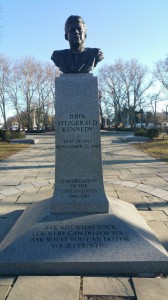This picture was taken at the Brooklyn’s Museum Grand Army Plaza. It is of the 35th President of the United States who served as naval officer during world war II and was also a Congressman from Massachusetts and a States Senator. He is being honored for the launched initiatives such as Peace Corps and with Great Britain and the Soviet Union signed the nuclear test-ban treaty of 1963. He also weathered the disastrous Bay of Pigs Invasion of Cuba (1961) and Cuban Missile Crisis of 1962. He was assassinated in Dallas on November 22, 1963, and was famous for his line “Ask not what your country can do for you; ask what you can do for your country.”
I like that he was recognized for such greatness. I also like his famous quote “Ask not what your country can do for you; ask what you can do for your country.”
This monument honors John Fitzgerald Kennedy (1917-1963), the thirty-fifth President of the United States.
After serving as a naval officer during World War II, Kennedy was a United States Congressman from Massachusetts from 1947 to 1953, and a United States Senator from 1953 to 1960. Narrowly defeating Richard M. Nixon in the tightly contested election of 1960, he was elected the nation’s first Catholic president. As president he launched initiatives such as the Peace Corps, and with Great Britain and the Soviet Union signed the nuclear test-ban treaty of 1963. He also weathered the disastrous Bay of Pigs Invasion of Cuba (1961) and Cuban Missile Crisis of 1962.
On November 22, 1963 he was assassinated in Dallas, Texas by Lee Harvey Oswald. Shortly after the assassination on November 22, 1963 of President John Fitzgerald Kennedy, Brooklyn Borough President Abe Stark proposed to Mayor Robert F. Wagner and Parks Commissioner Newbold Morris that a monument be erected in Kennedy’s honor. The American Institute of Architects sponsored the monument competition, and Morris Ketchum, Jr. and Associates were selected to design the monument.
The promontory where the monument is situated in Grand Army Plaza, was selected for its physical prominence, historic significance, and scenic beauty. The monument’s design went through an evolution, and one time included an eternal flame. Eventually the design was reduced to a more modest oblong pedestal sheathed in Vermont marble, from which projects a bronze portrait bust of Kennedy, crafted by noted Brooklyn-based sculptor Neil Estern (born 1926). Estern, then at the outset of his career, later served as president of the National Sculpture Society, also created the statue of Mayor La Guardia in Manhattan and a sculpture of Franklin Delano Roosevelt, Eleanor Roosevelt, and their dog Fala, at the FDR Memorial in Washington, D. C.
On August 24, 2010 the redesigned monument was rededicated. At that time Kennedy’s former speechwriter Ted Sorenson–often credited with the president’s most soaring rhetoric–commented: “It is fitting that the President, elected 50 years ago this year, who demonstrated more than any other since FDR his concern for the arts, John F. Kennedy, should be the subject of a superb work of sculpture in the heart of New York City, where his victory on November 8, 1960 clinched his election and his subsequent years in the White House devoted to the arts, social justice and world peace.”
President Kennedy’s daughter Caroline wrote: “I hope everyone who passes this memorial will reflect on his words ‘Ask not what your country can do for you; ask what you can do for your country,’ and consider how we can all contribute our talent and energy to the betterment of the nation.”
http://www.nycgovparks.org/parks/grand-army-plaza/monuments/854




